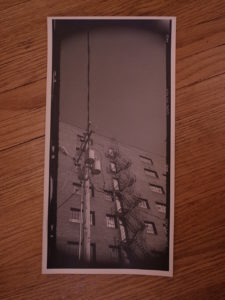This industrial black enamel and nickel ICA Polyskop is one of my favorite cameras.
I was looking for a cheap way to get high resolution panoramic images, and learned of this whole subset of cameras made in the early 20th Century – stereo-panoramics. There are several brands, all of them works of art, and If I could justify owning them all, I would.
There are gorgeous models such as the completely nickel plated Cornu Ontoscope. Another beauty is the Gaumont Stereospido.
Of the stereo cameras which don’t do panoramic, there are the WWI era Jules Richard Verascopes, finished in french military gray, snuck onto the battlefield from what I understand, to document trench warfare in full 3D. I say snuck onto because soldiers were not technically allowed to have their own cameras, for fear of images of the carnage of war reaching the French public, which was seen as a surefire way to weaken their appetite to continue the war.
Another model is the Franke & Heidecke Heidoscope (a glass plate model, with a roll film back option), which would eventually evolve into the Rolleidoscope (Rollei = designed specifically for roll film ), which would evolve yet again to become the Rolleiflex.
I had a few requirements when I got this ICA Polyskop:
- It had to use 120 roll film (not ready to coat glass plates, thanks!)
- It had to do both panoramic and stereo images for maximum versatility
- I did not want a camera which had a bellows, prone to light leaks or damage
- It had to work – after all these cameras are pushing 100 years old!!
After scouring the auction sites, there are very few models which cover these criteria. Most of the stereo-panoramic cameras only do glass plates. Some of them have roll-film back options – The Cornu Ontoscope had a rollfilm back option, but they are incredibly rare and run over $1000 easily. The Rolleidoscope / Heidoscope unfortunately does not do panoramic images due to the reflex finder being in the middle – no way to shift the front panel over to center one of the lenses on the film back. Verascopes also don’t do panoramic, but they do have a 35mm rollfilm back option.
Finally after a lot of searching I came across the lone ICA pictured above. Some craftsman in the past 80+ years has taken the main body, cut off the rails where one would have attached the glass plate magazine too, and crafted a homemade 120 rollfilm back onto it, with a massive 6×13 pressure plate. Everything on the back half of this camera is homemade. If this camera had not been modified, I would not own it.
Even the film advance knob’s stubby little sprocket teeth are soldered onto it by hand. This camera’s advance knob doesn’t fit the modern 120 rollfilm spindles, so when I want to use it, I get out my pocketknife and hollow out the center of the film spindle, pop out the homemade cotter pins holding the film advance knobs in, and gently put everything back in its correct place. It is a pain to load, but with practice it’s been getting easier.
For panoramic, the front plate with the 90mm Zeiss Tessars slides to the right so the leftmost lens is centered over the film. There is no double exposure prevention. The finder only really tells you what you would capture in stereo mode – and once it’s in panoramic, it’s not even centered anyway, making it hard to figure out where your left and right edges end. The 90mm lenses give about a 28mm angle of view on a 6×13 image, so what I do is take my Ricoh GR digital, frame up my image, then point the ICA, and set the GR with its digital level directly on top of it to make sure I’m not tilted one way or another. The ICA does have a built in bubble level (which still works) but it’s slightly off unfortunately compared to the GR.
The 6×13 images are the maximum width that you can print on a 4×5 enlarger – they come out looking like this.
The camera was only a few hundred dollars, way less than some of the other options. It’s definitely not the easiest to use of these options thoough.
It’s just so quirky. But these quirks are what make it one of my favorite cameras.
Check out a few images I’ve made with it here.




Leave a Reply